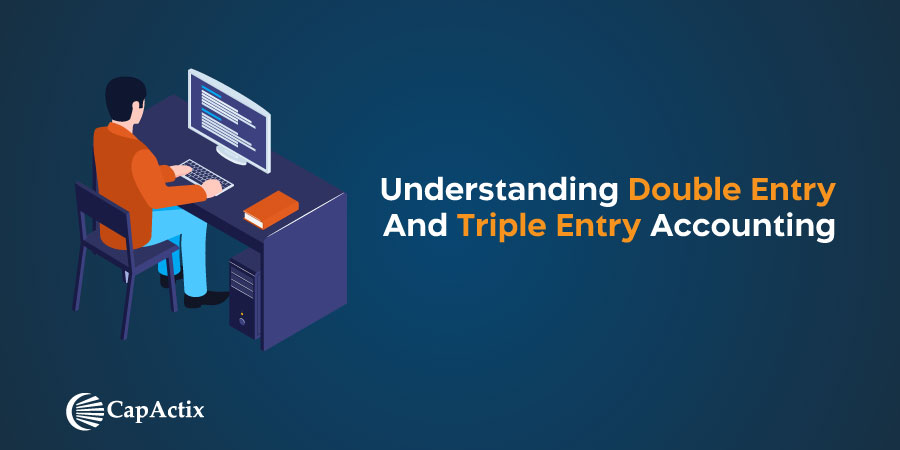While double-entry and triple-entry accounting is two methods of recording financial transactions, they are pretty different accounting techniques. A solid accounting system is essential for the smooth operation of a business and the organization of financial records.
Even when numerous accounting systems are available to choose from, the double accounting methods have remained in use for decades. Whereas, the implementation of triple-entry accounting started to gain traction in recent years. However, many business owners still tend to get confused between the two when they plan to opt for finance and accounting outsourcing.
Understanding double-entry accounting system
The double-entry system was first proposed in the 13th century, even though accounting practices remained for centuries. Double-entry accounting is a method of documenting financial transactions that involve two accounts for each transaction.
Double-entry accounting, invented by Luca Pacioli in 1494, is a scientific method of keeping financial records based on the duality principle. Every transaction impacts two accounts at the same time. One account receives a credit, while the other receives- a debit.
Because of the dual effect, the double-entry system is precise and thorough. It adheres to generally accepted accounting principles where every transaction gets tracked by a comprehensive interface. The process starts with the source documents, then moves on to the ledger, journal, trial balance, and finally- financial statement preparation.
Since this system performs an out-and-out recording of financial transactions, there is less risk of embezzlement and fraud. As a result of the dual element, unintentional mistakes can be easily identified, and accounts can be adjusted to correct them.
What is the main rule for double-entry accounting?
The main rule for double-entry accounting is that every financial transaction has two equal and opposite effects on the accounting equation, which must be recorded in two separate accounts. This is known as the “duality principle” of double-entry accounting.
In other words, for every transaction, there is a debit entry and a credit entry of equal value. The debit entry is recorded on the left-hand side of the account, and the credit entry is recorded on the right-hand side of the account.
This system ensures that the accounting equation (assets = liabilities + equity) remains in balance after every transaction. It also allows for accurate and comprehensive record-keeping, as each transaction is recorded in multiple accounts and provides a complete picture of the financial impact of that transaction.
What is an example of double entry?
A simple example of double-entry accounting would be recording a cash purchase transaction.
Let’s say a company purchases office supplies for $100 in cash. This transaction would be recorded as follows:
- The cash account would be debited (increased) by $100 to reflect the outflow of cash.
- The office supplies account would be credited (increased) by $100 to reflect the acquisition of the supplies.
The transaction would be summarized in a journal entry as follows:
Debit: Cash $100 Credit: Office Supplies $100
This journal entry would then be posted to the company’s general ledger, which is a complete record of all the company’s financial transactions. By using the double-entry system, the company ensures that the total debits and credits always balance and that the financial records are accurate and complete.
Must read 2023: Why you should consider Outsourcing Payroll Processing
Top benefits of double-entry accounting

1. Reduces errors
The financial position of a company can be distorted- by human error. However, due to the checks and balances provided by double-entry bookkeeping, this is less likely. Because the debit and credit amounts are equal in double-entry bookkeeping, errors are easily detected. Although errors- are reduced, they did not get eliminated.
2. Creates a paper trail
By leaving an audit trail, double-entry bookkeeping reduces theft. You can use audit trails to track transactions that get posted to the general ledger. If your cash balance appears to be excessively high on your balance sheet, you can investigate the transactions made to the cash account to see if they are correct.
3. Preparing financial statements
Because information is collected directly from the double-entry bookkeeping transactions, accounting information in companies that use double-entry bookkeeping is simple to prepare. Businesses must produce accurate financial statements in a timely and efficient manner. Financial statements are used by management to determine how well their companies are performing financially and to create budgets.
4. Financial Control
Double-entry accounting provides greater financial control, by ensuring that every transaction is recorded in two accounts, which provides a clear picture of the financial health of the business. This helps businesses to manage their finances better and make informed decisions.
5. Completeness
The double-entry system provides a complete record of all financial transactions, including the date, the amount, the account, and the reason for the transaction. This information can be used to create detailed financial statements, which can be useful for business owners and investors.
Understanding triple-entry accounting system
The 3E Accounting System is a scholarly concept that provides the framework for a new way to do accounting called triple entry accounting (or 3E). The concept was first proposed by Professor Yuji Ijiri in 1986.
Most of the issues that are not included by double-entry accounting get dealt with in this method. A reliable and accurate accounting system, it’s a high-level accounting system. Triple-entry accounting involves cryptographically securing all parties involved in the accounting process and linking them via a smart contract to a third entry.
Lastly, the third entry in the Triple Entry System is both a transaction and an invoice, which gets entered into the Blockchain. Along with each party having a receipt, it’s proof of a transaction between the two parties -using the double-entry system.
Triple-entry accounting records are cryptographically enclosed and distributed, making them nearly impossible to destroy or copy. For every dollar spent, a buyer records a credit in the account. Whilst sellers record cash receipts as a debit on two different accounting books.
Blockchain technology solves this problem by recording entries in the same shared database as a transfer between wallet addresses, which creates an interconnected network of permanent and objective accounting records instead of recording them separately in different journals. Integrity, auditing, and transparency are just a few of the advantages of a 3E accounting system.
You can Quick Go Through to Triple Entry Accounting and What Could Be Its Future?
What is the main rule for triple-entry accounting?
Triple-entry accounting is a theoretical concept proposed to enhance traditional double-entry accounting by adding a third entry for each transaction. The main rule of triple-entry accounting is that every transaction must involve three parties and three entries.
In triple-entry accounting, each transaction involves a debit and credit like traditional double-entry accounting, but it also involves a third entry that is recorded on a blockchain or other distributed ledger. This third entry is a cryptographic receipt that provides an immutable and tamper-proof record of the transaction.
The three parties involved in each transaction are the buyer, the seller, and the network. The buyer and seller record the debit and credit entries in their respective accounting ledgers, and the network records the third entry in the blockchain or distributed ledger.
The triple-entry accounting system provides an additional layer of security and transparency because it creates an independent and verifiable record of every transaction that can be accessed by all parties involved. It is still a theoretical concept and is not widely used in practice.
What is the example of triple entry?
The concept of triple-entry accounting is still a theoretical concept, and its implementation in practice is limited. However, here is a simplified example of how triple-entry accounting could work:
Let’s say that Company A purchases goods from Company B for $1,000. In triple-entry accounting, this transaction would involve three entries:
- Company A’s debit entry: Company A would record the decrease in cash (or increase in accounts payable) by $1,000.
- Company B’s credit entry: Company B would record the increase in cash (or decrease in accounts receivable) by $1,000.
- Network’s third entry: A cryptographic receipt of the transaction would be created on a blockchain or distributed ledger. This receipt would record the details of the transaction, including the amount, date, and time, and would be stored in an immutable and tamper-proof manner.
This third entry would serve as a verification of the transaction, providing an additional layer of transparency and accountability. All parties involved could access the blockchain or distributed ledger to confirm the details of the transaction, ensuring that there are no discrepancies or disputes.
It’s worth noting that this is a simplified example, and implementing triple-entry accounting in practice would involve more complexity and technical considerations.
Must read What Experts say about Offshoring Accounting & Bookkeeping
Top benefits of triple-entry accounting

1. Distributed control
The jurisdiction no longer rests on one hand as the data is transferred to all related hosts. As a result, data is consistent and reliable across companies because everyone has equal access to it.
2. Precision
Because the data remains connected to all the associated companies, the chances of a mistake or misunderstanding between two parties- are reduced. As a result, data entry is more accurate and less prone to errors and omissions.
3. Electronic contracts
The electronic contract software is programmed to work when all of the required details are fulfilled. As a result, related actions, such as payments, are only carried out automatically when a corresponding trigger approves them. Eventually, more double-data-entry systems will get converted to triple-entry accounting, a much more reliable and advanced technology.
4. Improved Security
One of the primary benefits of triple-entry accounting is improved security. In the traditional double entry system, transactions are recorded in two separate ledgers. In triple-entry accounting, a third ledger is created that uses cryptography to secure transaction information. This makes it nearly impossible for fraud to occur, and also helps to protect against data breaches and other security threats.
5. Improved Accountability
Triple-entry accounting helps to improve accountability by providing a clear and transparent record of all transactions. This can be particularly important in situations where there is a need for accountability, such as government transactions or financial reporting for public companies.
Comparison between double-entry v/s triple-entry accounting
Every financial transaction gets recorded in two separate accounts, a debit to one account and a credit to another. When it comes to virtual currency and blockchain-based, double-entry is one of the most crucial accounting systems today, but it’s also one of the least reliable.
The ledgers can be easily deceived and changed since the adjustments are based on personal judgment, and human error may be hard to locate when payments get incorrectly recorded. This adds a third element to the debit-and-credit accounting system in triple-entry accounting. However, there is a slight misconception about this term as it does not create a third entry.
Instead, it adds a third component known as the Bitcoin network with foundational “blockchain” technology to the double-entry accounting to link every element of a transaction and primarily seal it (the third entry), so it can never get altered or deleted again.
By utilizing this technology, the accounting standard will become revolutionized with a real-time ledger established. It significantly reduces errors and fraud thus, making an audit trail for every aspect of a transaction.
This ground-breaking blockchain technology will safeguard information and communications in the accounting process while also ensuring complete transparency throughout the accounting and auditing processes.
Must read Virtual CFO vs In-house CFO: Complete comparison 2023
The Bottom Line
To sum up, we can say that both double and triple-entry accounting comes with its set of benefits and limitations. Nevertheless, due to its advanced blockchain technology, triple-entry accounting is gaining popularity amongst businesses. However, many companies and tax firms still do not fully understand its application and opt for finance and accounting outsourcing to streamline their finances and business accounting.
If you are looking for a reliable partner for your offshore accounting services, look no further than CapActix Business Solutions.
CapActix is a prominent name that provides high-grade accounting outsourcing services, given the immense industry expertise and vast pool of proficient CPAs and accountants. To know more about our services, visit website.
















